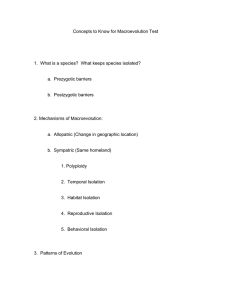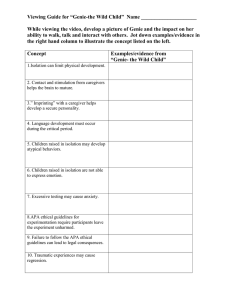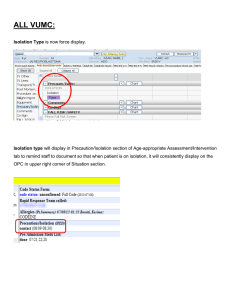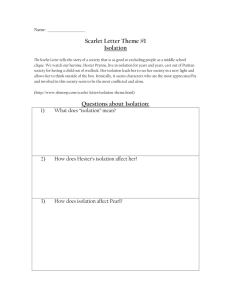anglo fatal risk standard aa afrs 6 isolation issue 2 contents page 1
advertisement
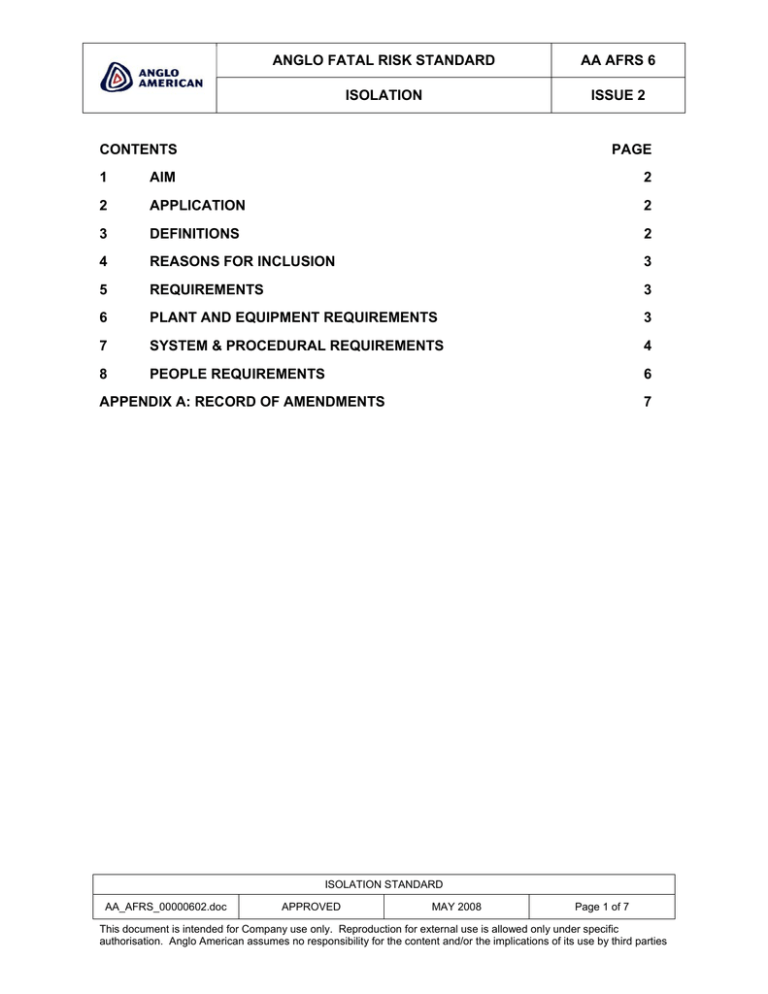
ANGLO FATAL RISK STANDARD AA AFRS 6 ISOLATION ISSUE 2 CONTENTS PAGE 1 AIM 2 2 APPLICATION 2 3 DEFINITIONS 2 4 REASONS FOR INCLUSION 3 5 REQUIREMENTS 3 6 PLANT AND EQUIPMENT REQUIREMENTS 3 7 SYSTEM & PROCEDURAL REQUIREMENTS 4 8 PEOPLE REQUIREMENTS 6 APPENDIX A: RECORD OF AMENDMENTS 7 ISOLATION STANDARD AA_AFRS_00000602.doc APPROVED MAY 2008 Page 1 of 7 This document is intended for Company use only. Reproduction for external use is allowed only under specific authorisation. Anglo American assumes no responsibility for the content and/or the implications of its use by third parties 1 ANGLO FATAL RISK STANDARD AA AFRS 6 ISOLATION ISSUE 2 AIM To ensure that all machinery and equipment is isolated, locked out and made safe (all energy released) prior to any access, work or repair being carried out, in order to protect the health and safety of persons. 2 APPLICATION This Standard is applicable, but not limited to all sources of energy including potential kinetic, elastic, chemical, electrical, mechanical, thermal (e.g. hot liquids, solids, gases), nuclear, static, rotational, out of balance, light and gravitational. Energy associated with processes such as materials handling, transport, pressure, vacuum, hydraulic, pneumatic and chemical processes, are also included. Moving and stationary machinery is included. This Standard stipulates the minimum requirements to which the isolation, lock-out and making safe procedures must comply. This Standard applies to all Anglo American Group managed businesses and operations, including contractors and visitors when involved in controlled activities. 3 DEFINITIONS • AUTHORISED PERSON means a competent person tested and appointed in writing by the responsible supervisor to do specific operations (i.e. operating electrical switchgear). • RESPONSIBLE SUPERVISOR is the manager/engineer in charge of the Operations as per legal definitions or internal regulations. • OPERATOR means the person in charge of the operation of some specific equipment or machinery. • DE-ENERGISE means to remove effectively all possible sources of energy from the item, system, process, area or equipment in question. • EARTHED means connected to the general mass of earth in such a manner that will ensure at all times an immediate discharge of electrical energy without danger. • ISOLATION means to physically remove any connection or means to supply any form of energy to equipment in order to make energisation of such equipment impossible. • LOCK OUT means to put a personal lock or appropriate device on to equipment in such a way that it would be impossible to connect, switch on or start, utilise or energise the equipment without removing the lock or device. • MAKE SAFE means to remove any threat or potential threat to health and safety posed by the source of energy, equipment, any equipment in the vicinity, any other substance or charge in the immediate area. This includes, but is not limited to, barricading, clamping, chocking, constraining, deflating, earthing, neutralising, purging and ventilating. • PERMIT-TO-WORK means a form of written declaration signed and given by the person legally responsible for the Plant to the person in charge of work to be carried out on machinery or equipment that has been isolated, locked out and made safe. ISOLATION STANDARD AA_AFRS_00000602.doc APPROVED MAY 2008 Page 2 of 7 This document is intended for Company use only. Reproduction for external use is allowed only under specific authorisation. Anglo American assumes no responsibility for the content and/or the implications of its use by third parties 4 ANGLO FATAL RISK STANDARD AA AFRS 6 ISOLATION ISSUE 2 REASONS FOR INCLUSION A significant proportion of our potential fatalities have included cases where sources of energy were not isolated adequately. The causes of and factors contributing to these incidents have been: 5 • Failure to identify or recognise a source of potential or stored energy; • Inadequate training or lack of competence; • Inadequate lock-out/tag-out systems; • Complacency; • Working on, or isolation of, the wrong equipment; • Inadequate design/maintenance of isolators. REQUIREMENTS Application of the Anglo Fatal Risk Standards is mandatory at all Anglo American managed businesses and operations. This mandatory nature is indicated by the use of the word “shall” within the Standards. In some places, the word “should” is used. This means that the primary intent remains, but specific circumstances may mean that implementation of the requirements is not reasonably practicable. Any deviation from the specifications set forth in these Standards should be formally approved following an exemption procedure. The exemption procedure comprises the following steps: 6 1. Documented and detailed description of the implementation difficulties 2. Documented and detailed risk assessment of the situation under proposed alternative control measures 3. Documented formal approval from the divisional head of safety and the divisional chief executive officer that the level of risk as a result of the alternative control measures is understood, tolerable for the organisation and in line with the Anglo American group vision of zero harm. PLANT AND EQUIPMENT REQUIREMENTS 1. All equipment whether purchased or constructed (including hired and contracted equipment), shall have the capability of being isolated physically from all energy sources and shall meet the requirements of this Standard. 2. Isolation shall provide positive protection against harm and shall be achieved by the use of locking devices or the establishment of a physical barrier or separation. 3. Personal locking devices shall be unique and: - not be combination locks, ISOLATION STANDARD AA_AFRS_00000602.doc APPROVED MAY 2008 Page 3 of 7 This document is intended for Company use only. Reproduction for external use is allowed only under specific authorisation. Anglo American assumes no responsibility for the content and/or the implications of its use by third parties 7 ANGLO FATAL RISK STANDARD AA AFRS 6 ISOLATION ISSUE 2 - not have an unauthorised second-party master override key, - be kept under the exclusive control of the owning individual, and key(s) shall not be transferred to another person for lock removal. 4. Designated isolation points shall be labelled clearly to identify the circuit or system being isolated or locked out. These labels shall be applied following a process of pre-isolation identification using the lock-out procedure. - 5. All designated isolation points fitted with personal locking devices shall be tagged. The isolation tagging system shall ensure that: - isolation points are identified positively, including the name of the person locking out, - the reason for the isolation is identified clearly, - isolation tags are highly visible to prevent inadvertent operation. SYSTEM & PROCEDURAL REQUIREMENTS 6. An isolation, lock-out and making safe procedure shall be in place to ensure correct isolation and that all equipment is made safe prior to gaining access or commencing any operation, cleaning, maintenance or repair work requiring access to parts of a machine or removal of a guard or interlock. The procedures shall define clearly the responsibilities of all parties involved. 7. The lock-out procedure shall include the following: - Visible indication of isolation, - Clear identification of the machinery or equipment to be locked out by the operator, - Formal hand-over of the control of the equipment from the operator to the authorised person, - Duties and responsibilities of both the operator and the authorised person, - Sequence of events to be followed during the procedure, - Formal hand-over of the control of the equipment back from the authorised person to the operator, - As determined by risk assessment, isolation of high-energy sources or other high-risk work requires a “permit to work”. When permits are required, the authorised person must isolate, test for dead and earth the equipment before issuing a “permit” to the person responsible for the work. This person then completes the lock-out according to the applicable procedure, - A list of site-specific procedures for which a “permit to work” is required should be approved and communicated by the responsible supervisor. 8. The lock-out procedure shall begin with a risk assessment to ensure that work is undertaken safely. 9. All parties involved shall identify the equipment before the authorised person deenergises isolates or locks out equipment. All parties involved shall ensure that the equipment cannot be energised or operated inadvertently. There shall be provision ISOLATION STANDARD AA_AFRS_00000602.doc APPROVED MAY 2008 Page 4 of 7 This document is intended for Company use only. Reproduction for external use is allowed only under specific authorisation. Anglo American assumes no responsibility for the content and/or the implications of its use by third parties ANGLO FATAL RISK STANDARD AA AFRS 6 ISOLATION ISSUE 2 for multiple locks, if required. Each person working on the equipment shall apply his own personal lock to prevent the isolation being removed. 10. Once equipment has been isolated and locked out, it shall be the responsibility of the authorised person to safely test that the equipment is made safe (all energy is discharged). The type of test shall depend on the equipment but, in all cases, all energy shall be discharged or controlled. This test shall be described in the lock-out procedure. Only instruments approved for this purpose shall be used for these tests. The tests shall include, but not be limited to: - Pressure, - Voltage, including induced voltage, - Redundant charges, - Elevated equipment, - Enclosed areas, - Hazardous chemicals (particularly in confined spaces), - Stored electrical energy, - Temperature, - Equipment under tension (e.g. conveyor belt), - Equipment requiring regular operator access (e.g. chutes, screens) - Sources of gas, - Mobile equipment. 11. All machinery or equipment that can cause harm in the immediate area shall also be made safe. 12. Confirmation of isolation, lock-out, appropriate testing and making safe shall be recorded and signed for by all affected parties. 13. A warning sign, stating that specific machinery has been de-energised because work is in progress, shall be posted at the points of isolation. 14. Only after all these procedures (Elements 7-13) have been adhered to, shall work commence on the equipment. 15. After completion of the work, a hand-over procedure back to the operator shall be in place. 16. For audit trail and risk management, the responsible supervisor shall, on a regular basis: - Re-assess the competence of the authorised persons, - Audit the lock-out records and “permit to work” documents, - Undertake a risk assessment on the lock-out procedure, - Undertake planned task observations. ISOLATION STANDARD AA_AFRS_00000602.doc APPROVED MAY 2008 Page 5 of 7 This document is intended for Company use only. Reproduction for external use is allowed only under specific authorisation. Anglo American assumes no responsibility for the content and/or the implications of its use by third parties 17. 8 ANGLO FATAL RISK STANDARD AA AFRS 6 ISOLATION ISSUE 2 All safety incidents, including near hits, shall be reported, investigated and analysed. Corrective and preventative actions shall be taken and closed out and the learnings shared as per the ANGLO SAFETY WAY. PEOPLE REQUIREMENTS 18. The person in charge of the operation of the equipment shall be clearly identified and this shall be recorded. This person shall be identified as the operator for the purposes of this Standard. 19. All individuals issued with personal locking devices shall be provided with training and have their competence assessed on a regular basis. 20. The responsible supervisor is the person appointed in terms of applicable legislation or internal regulations. The responsible supervisor shall: 21. - ensure that all lock-out operations are carried out in terms of the lock-out procedure - authorise suitably competent persons in accordance with requirements - ensure and record that all authorised persons remain competent (by means of observation audits and re-training) to carry out their duties - ensure that the lock-out procedure remains current and that it is updated when necessary (e.g. annually) to provide for equipment and/or process modifications - ensure that the lock-out procedure is adhered to continually by conducting verification exercises such as planned task observations. The authorised person shall be responsible for the safe execution of isolation and lock-out duties as per the lock-out procedure (Element 7). ISOLATION STANDARD AA_AFRS_00000602.doc APPROVED MAY 2008 Page 6 of 7 This document is intended for Company use only. Reproduction for external use is allowed only under specific authorisation. Anglo American assumes no responsibility for the content and/or the implications of its use by third parties ANGLO FATAL RISK STANDARD AA AFRS 6 ISOLATION ISSUE 2 APPENDIX A: RECORD OF AMENDMENTS Issue 1 : New document (L.Menéndez Version 1, December 2007). Issue 2 : Updated document (L.Menéndez Version 2, May 2008). ISOLATION STANDARD AA_AFRS_00000602.doc APPROVED MAY 2008 Page 7 of 7 This document is intended for Company use only. Reproduction for external use is allowed only under specific authorisation. Anglo American assumes no responsibility for the content and/or the implications of its use by third parties
